-
Posts
1,742 -
Joined
-
Last visited
-
Days Won
3
Content Type
Profiles
Forums
Blogs
Gallery
Events
Store
Posts posted by Greg Collins
-
-
Just took a look at Dr. Battushig's book and, after looking at the example of the post '90 version (brass) of the award (which is showing several of the same features I listed above), I really can't tell whether yours is genuine or fake. Sorry for the inconclusive answer.
0 -
Mogul,
While I do not own one of these awards in my Mongolian collection, I will say that there are details I don't like that I'm seeing here, especially in the reverse image. Very rough, uneven edges are all over the place, the scratching below the pin assembly, the pin assembly itself seems to have been cut with metal shears. The front seems to be showing a fair amount of verdigris at the bottom (could be the lighting)- unusual for this award. While the red and yellow painted areas look basically ok, the blue and green areas look sloppy and both colours are considerably off-tint. Take a look at this:
http://gmic.co.uk/index.php/topic/13677-fakes/page__st__20
Posts #34 and #35 and form your own opinion.
0 -
There are a fair amount of these "floating around", though rarely for sale- families tend to keep those as cherished memories of the dearly departed- remember, we're talking Southern Culture here, and from baby boomers (me) back, that tends to be the way it is. Younger generations have a somewhat more relaxed approach. The three organizations mentioned so far (UDC, SCV and MOS&B) have chapters or camps (SCV terminology) in most towns or cities of reasonable population throughout the South. Here in Virginia, if you have at least one traffic light and a gas station, you probably have an SCV camp nearby. And, where these camps or chapters exist in concert with local veterans, these medals exist.
0 -
The qualifications for this award are that the recipient either has been in an established war zone (by established, I am referring to a hostile environment with it's own medal: Viet Nam, Iraq, Kuwait, Afghanistan, etc.) or other hostile zone for which an Expeditionary Medal is awarded (an example of this would be Beirut in 1983). The ribbon colour will change according to the conflict. So far, the requirements are virtually the same for membership in the Veterans of Foreign Wars. Here's the catch: the recipient must be the documented descendant of a Confederate soldier or sailor. The Sons of Confederate Veterans has a comparable award, as does the Military Order of the Stars and Bars... although, with that particular organization, you must be the documented descendant of a Confederate Officer or cabinet member of the Confederate government.
0 -
Thanks for the follow-up. Very interesting order... similarities with the Order of the Red Banner are unmistakable (torch and star center; makes me wonder which inspired which due to the date given); wreath made of both oak- strength- and laurel- victory- leaves, derrick and anvil and the almost obligatory red banner with "Workers of All Nations Unite" emblazoned thereupon. Very nice piece. Congratulations on owning it!
0 -
Thanks Mogul... I've not seen one of these before. The rivets on the flag and torch are interesting in that they can be seen from the front. Also interesting is the construction of the badge as evidenced by the prongs on the backplate. I'm curious as to the first letter of the republic's abbreviation at the top right of the star "_SFSR". What is the first letter and do you have an approximate date on this piece?
0 -
Great stuff, Nick! Now, what happened to the pearls?
0 -
Yep, you're absolutely right- star is gold instead of silver. Eyes shot and brain slowing... :wacky:
0 -
Nice ribbon bars, Kevin! I especially like the 4th Class Star- haven't managed to snag a ribbon bar with that ribbon aboard- yet. :cool:
0 -
Excellent job on a fascinating subject, Nick!
0 -
Hauptmann,
Thanks for posting this; takes me back to when I recommissioned and sailed aboard the USS New Jersey (BB-62). We were the first to be recommissioned back in '82; I believe the Iowa was the second. As it turned out, all four Iowa class Battleships were recommissioned and, with the release of this information, all four are now museums BUT are being kept in some state of readiness (just in case). The New Jersey is in Camden Ship Yard, the Missouri is in Pearl Harbor and the Wisconsin is in Norfolk.
Some miscellaneous information from one who served aboard this class of ship:
The Iowa class Battleship is a "doomsday" vessel. As proved by the incident in '89, she can take her own firepower- something that was always assumed since '43. Prior classes of Battleship were built tough, but not as tough as these (interesting tidbit: the famous photo of the Bikini Bomb test, shortly after the war, in which you can see a ship being pulled "up the pipe" of the mushroom- that's the USS Pennsylvania. Well, that was the only ship that was outright sunk by the blast. The others were sunk by sailors who travelled ship to ship and openned up the discharge valves allowing the sea to enter the engineering spaces. One of those sailors was Leroy Collins, my cousin- also searved as a coxswain during the Normandy landing- he told me that the outside of the older battleships was quite charred, but the inside looked untouched). These ships were built to withstand whatever was thrown at them... the hull is a tri-laminate of steel coming in at a thickness of 18" in most areas.
33 knots is a low-end estimate (the speed of a ship is not only dependant on the machinery but on the ocean current as well). We had the New Jersey up to 40 knots while I was on her and that, with only 2 screws (normal operation)! Oh yeah, it's 887 feet and 4 inches- didn't want to leave that out, and the displacement (weight) is 49,000 tons- I still have trouble imagining that figure as I was often under her when she was on blocks in Long Beach Ship Yard.
The Iowa class Battleships are absolutely magnificent examples of what ships should be: gorgeous lines, they sit in the water beautifully and ride the waves like no other type of ship. It was a priviledge to searve aboard one.
The '89 incident was caused by bad powder (this powder had been in storage since WW2); the other "crap" was created by the Dept. of the Navy as a cover-up (this info is based on conversation with a very good friend who was my Master Chief aboard New Jersey and who transferred to recommission the Iowa and was on hand at the time of the incident and knew all involved). Apparently, the Navy paid it's way out of that and we haven't heard anymore about it.
0 -
Thanks, Dave!
Sorry to say it, but the ring looks a hell of a lot better than I do these days :-(
0 -
And, finally, the maker's mark and gold content. As you can see, the camera chose not to focus on this information, but you can still make it out easily...
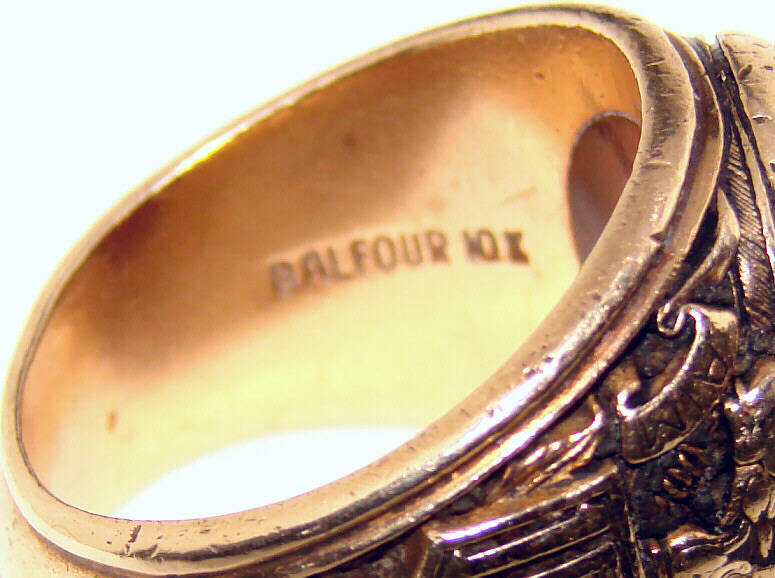 0
0 -
The right side shows a portion of the Academy's emblem of that time (it may have changed since)...
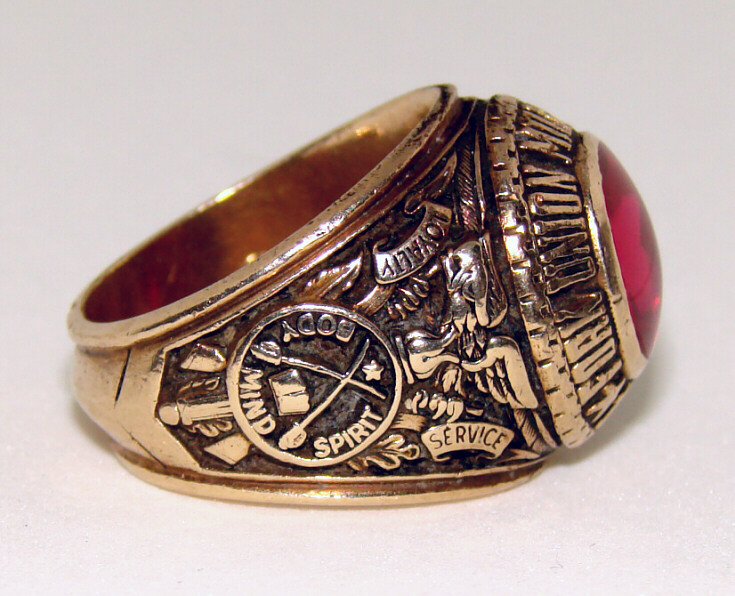 0
0 -
The left side showing the class year...
 0
0 -
As far as company reps, I believe this is handled on a case by case basis. At FUMA, the choices were, at the time I went, red or blue setting- hence the order could be taken by an employee of the Saber Shop (cadet store on campus). May not be the same for all cases. We bought ours sometime in the middle of our junior (11th grade) year; 1971 for me. Costs me $52 back then and I thought that was highway robbery; man, have times changed! Here's a few images of the beast, dings and all. Sorry for the soft focus on the maker's mark- I and the camera disagreed; the camera won.
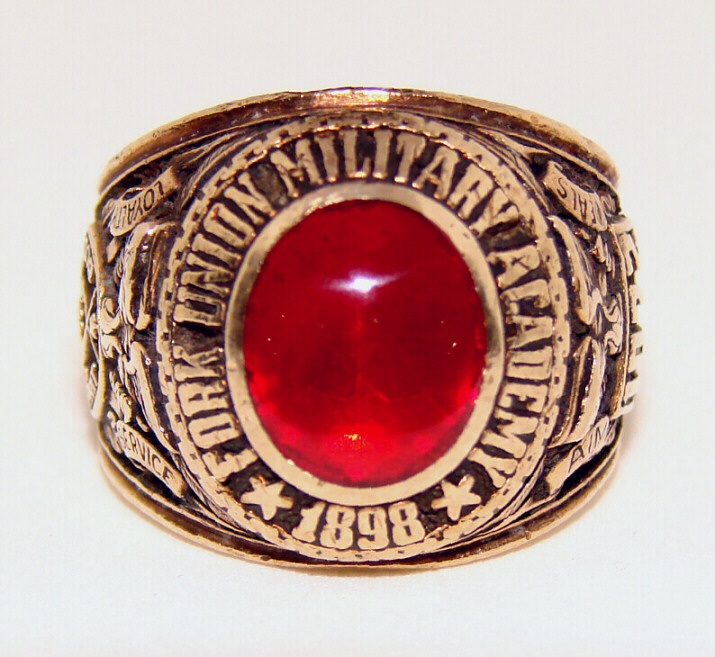 0
0 -
ostprussenman,
Virginia Tech (Virginia Polytchnic Institute and State University when I was there) has a huge number of styles, stones and even gold (and other metal) types that it can cause sensory overload trying to pick one- this is definitely NOT an overstatement. The type usually chosen by "manly men" is very large with a square-cut setting; slightly larger than my FUMA ring. In thinking back and remembering viewing the display, I never knew gold could have so many varieties as what I saw offered.
By the way, the Cadet Corps at Tech does not comprise the majority of the University. When I was there (early '70's) there were only about 800 cadets, and about four times that in civilian students.
0 -
I never purchased a college ring... don't know why; just didn't. Perhaps it is because (at least in my mind) my high school, Fork Union Military Academy, was a hard act to follow. Very tough school (I was there from January 1968 until May 1972) and quite rewarding knowing that you got through it. I did get a class ring there which I do wear upon occassion; cost me $52 back in 1971 and it was made by Balfour, I believe. 10 karat with a tall shank and smooth red setting. Very heavy; someone told me it was 17 penny weight (whatever that means). I guess getting through FUMA matters more to me than what I did in college; it certainly prepared me for the Navy and college, that's for sure.
A ring was produced for the recommissioning of the USS New Jersey BB-62 by Jostens, but I never had the opportunity to get one; I put it off, as it was somewhat expensive, thinking I had all the time in the world. Well, that time "stopped" in Beirut in 1983 as I was MEDEVACed out of the area and off the ship. I have always wanted one of those rings; maybe I'll find one someday before it's all over.
0 -
Great find, Kevin!
 0
0 -
Beautiful set, Frank!
 0
0 -
And the back:
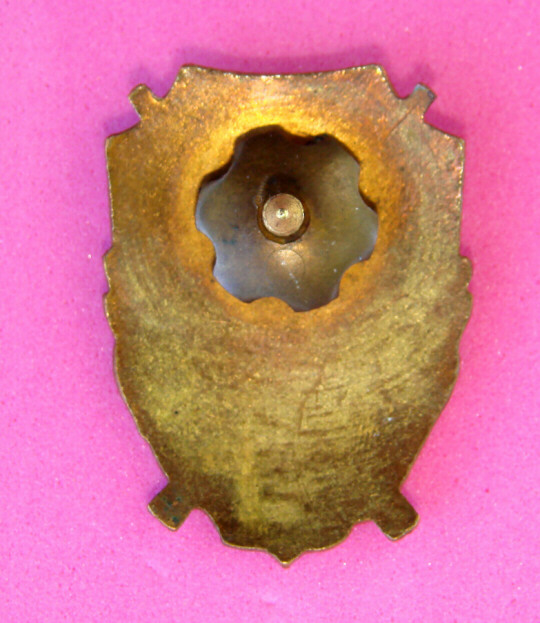 0
0 -
An enlargement of the State Seal:
 0
0 -
Oooops, double post. Sorry...
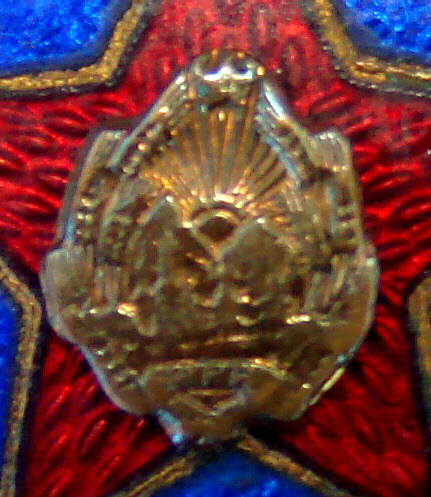 0
0 -
Ok, ok, I know I said "a couple...", but I thought I'd try to squeeze another one in here before starting another thread. The RSR variation of the badge is the only version I had seen, and I did not think this badge existed in an RPR version until now. Well, here it is, the "For Militia Merit" RPR badge. The only differences between this RPR variation and RSR variations are the State Seal and the screw back.
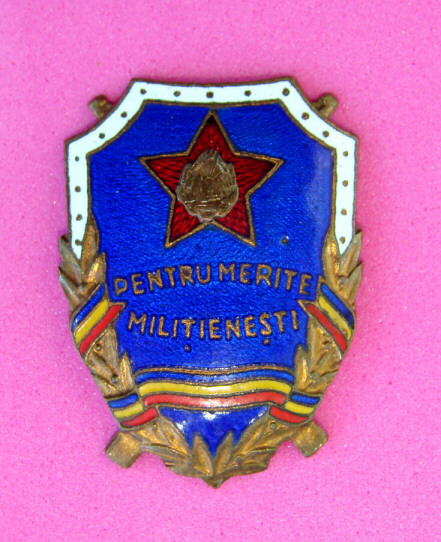 0
0



MVD badge of the "Office against organised drug traficking" ?
in Russian Federation
Posted
Nice!